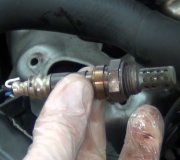"Hi, Just wanted to ask a few follow up questions on the exhaust emission light. Now since the mechanic has erased the code. How long would it take for the problem to come again and it would it just help if I changed the oxygen sensor or the crankshaft sensor? Because if it comes when I am on the motorway heading home, I would not be able to go to a garage and my motorway journey tkaes 6 hours. I was wondering if for the symptoms I had mentioned earlier would prove for either a sensor to be faulty? Please help me. Many Thanks"
Please don't start a new question each time. Follow the link in your automated e-mail to come right back to this thread. I might not see your new question and the other people aren't going to want to jump into the middle of a conversation they know nothing about. That does you a disservice.
As far as how long it will take for the problem to act up again, there is know way to know that. If I knew the code, I could guess at some generalizations, but with intermittent problems it can be minutes, weeks, months, or never. That's why knowing the code is so important.
Changing random parts is not the answer, and it will add new variables to the problem. No two sensors are ever exactly the same. The Engine Computer has to learn the characteristics of the sensors by comparing them to each other and various operating conditions. When a problem is detected, it may not be bad enough or have lasted long enough yet to set a fault code, but it can prevent the computer from relearning the new sensor's readings. That can cause the engine to run worse due to the new sensor reading differently than the old one, or it can run better because the computer thinks there's a problem with that new sensor so it disregards it and "injects" pre-programmed backup values to run on.
Your car is going to have multiple oxygen sensors. If one is defective, the computer will set the appropriate fault code. When they're working properly they simply report the amount of oxygen in the exhaust. If that amount is wrong, you don't replace the sensor; you find and fix the cause. Don't replace the messenger because you don't like the message. The oxygen sensors after the catalytic converter only report on its efficiency. They have no bearing at all on how the engine runs.
If the crankshaft position sensor fails, the engine will stop running. On some car brands those sensors sit high up on the engine where heat migrates to when the hot engine is stopped. Very often they fail by becoming heat-sensitive. The symptom commonly is the engine runs fine as long as you keep on driving and air is flowing over the engine, but when the engine is stopped for a few minutes, the heat makes the sensor fail resulting in a no-start condition until it cools down for about an hour, then it will work again.
Most commonly an engine misfire like you described originally is caused by old spark plugs and wires but there are many other potential causes. The fault code could be the result of that misfire, or it could be indicating the cause of the misfire. At this point you really have to wait for the problem to occur again so we can see what code is set.
Tuesday, January 7th, 2014 AT 2:39 PM


